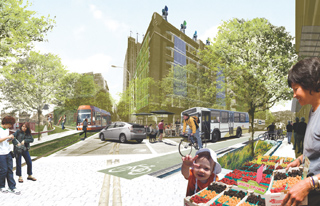|
Subscribe / Renew |
|
|
Contact Us |
|
| ► Subscribe to our Free Weekly Newsletter | |
| home | Welcome, sign in or click here to subscribe. | login |
Environment
| |
 |
February 17, 2011
EcoDistricts: Sustainability that goes beyond buildings
Mithun

Frank
|
District-wide sustainability is a concept that builds on the foundation of green building. It not only covers site-specific projects and new development, but also broader considerations such as social cohesion, materials management, habitat and ecosystem restoration, and large-scale energy conservation and generation.
Neighborhood-scale sustainability innovation zones, or EcoDistricts, are the new testing grounds for sustainability best practices that not only address urban form, but livability, community vitality and health within a larger context than a single building or site.
Framework for action
Rather than applying traditional community development approaches such as asset mapping and community prioritization, the formation of EcoDistricts begins by linking place, ecology and technology through engagement-driven analysis. This means that neighborhood groups have a significant stake — and voice — in the discovery and decision-making process.
The formation of an EcoDistrict brings together stakeholders from existing neighborhoods, who provide feedback and research specific to a given location. EcoDistricts can be steered by nonprofit organizations, cities, neighborhood groups, utilities, land owners or public institutions — the key is gathering all of these groups at the table, no matter who is driving the process.
Together, they examine existing conditions to find advantages and challenges unique to their district, evaluate sustainable strategies to determine the most suitable and impactful, and monitor performance over time in an iterative process that informs future decisions.
A series of emerging initiatives are identifying similar opportunities and challenges at the neighborhood scale. EcoDistrict models like the Green Impact Zone in Kansas City, Mo., or Seattle’s 2030 District focus on a specific locality, while Living City Block seeks to create an exportable model for existing downtown mixed-use districts.
Portland’s EcoDistricts Initiative, led by the Portland Sustainability Institute (PoSI), is designed to provide a framework for carrying out comprehensive strategies that push district-scale sustainability development across all neighborhood types.
“The goal of our EcoDistricts Initiative is to provide a framework that neighborhoods anywhere can use to organize, set goals, successfully implement projects, and ultimately monitor their sustainability performance over time, says Naomi Cole, EcoDistrict program manager with PoSI.
“We are piloting this approach in five different neighborhoods here in Portland and will continue to refine our toolkits and methods as we learn more.”
Building a process
One of these tools is the EcoDistrict assessment methods. It can be applied to a range of potential EcoDistrict types, including new developments, neighborhood redevelopments, existing downtown cores, institutional campuses, business districts and residential neighborhoods. The goal of this approach is to provide a standard process that determines performance so that neighborhoods can develop strategy recommendations in pursuit of district-wide sustainability.
PoSI is working with five pilot EcoDistricts in the Portland area to explore the application of this methodology: Lents, Portland State University, the Lloyd District, Gateway Regional Center and South Waterfront/North Macadam. The Lloyd District may become the first off the ground.
Most notable is that PoSI’s work is supported by a well-informed, professional staff on the ground in Portland, something that other district methodologies may not immediately have in place. Those staff members have been busy creating an engagement and governance strategy over the last several months, and are currently developing an assessment and management toolkit.
PoSI’s assessment toolkit consists of protocol that districts can choose to carry out themselves or with PoSI’s assistance. The protocol includes a series of 10 steps that begin with creating a baseline, setting targets and matching EcoDistrict character with unique opportunities.
After screening a menu of potential strategies, the assessment team vets those that appear most impactful by identifying the number of projects that each can support. The strategies culled from this group are then tested for feasibility and matched with a phasing and implementation plan. Once each project is launched, the assessment team monitors its progress, which informs the overall EcoDistrict initiative.
Using this process, the PoSI’s EcoDistricts Initiative breaks down performance into the following areas: materials management, access and mobility, social cohesion (education, services), equitable development (density, housing affordability), placemaking (community services, lease and vacancy rates), and air quality and carbon, energy, water, habitat and ecosystem function. By coordinating data and engagement-driven analysis with a database that collects and visualizes performance of each strategy within a performance area, team leaders can monitor change over time and share data publicly.
Over the past year, PoSI has worked with a series of technical advisory committees to establish performance-area goals and potential metrics. PoSI then hired a team to create the assessment methods, which included Mithun and researchers at Portland State University.
“There is precedence for a district-wide sustainability framework based on work we’ve completed in sustainable campus planning,” says Brodie Bain, a principal at Mithun.
“This framework articulates vision, goals, metrics and strategies in an institution’s path toward climate neutrality. PoSI’s work is pushing the boundaries by striving for a standard system of planning that results in tangible, district-wide actions for multiple landowners.”
The team also recommended potential metrics based on available data and relevance to performance-area goals.
Vivek Shandas, an associate professor at Portland State, is the leading the effort to develop metrics that are both meaningful and grounded in the realities of data availability and analysis.
He notes, “Although the process has brought to light the importance of data in neighborhood-scale assessments, we’ve learned that empowering the community to define, direct and deliver on locally relevant datasets is essential.”
Challenges
The advantage of PoSI’s EcoDistricts model is also its central challenge: creating protocols suitable for any place that work for every place.
Due to the broad range of study areas and strategies that make the model readily applicable to many situations, this approach requires significant coordination and clear communication between all involved. The model also requires those leading the process to continually ensure that they are posing the right questions, pursuing achievable goals and acting in accordance with local climate action plans.
Another hurdle facing the adoption of the EcoDistrict model is the need for governance and community engagement infrastructures. If they’re not already in place, a ramp-up of the engagement process includes gathering political and community momentum to capture support and inform the process.
It is equally critical that teams have access to data relevant to decision making. Sometimes, datasets are not readily available, or the team may discover that no one has yet collected the data they require.
Unlike metrics for stormwater or energy, quantitative data may be difficult to achieve for “softer” sciences like community cohesion, placemaking, or equitable development.
PoSI is now beginning to roll out the assessment method model for its first five neighborhoods. Many of these districts are in the process of creating a governance structure to guide their EcoDistrict work.
In 2011, PoSI’s focus is to shape representative governance structures with the capacity and expertise to participate in assessment, prioritize projects and ultimately move forward with project implementation and performance monitoring.
Gabriela Denise Frank, an associate at Mithun, is a Seattle writer and author of the upcoming book, “CivitaVeritas: An Italian Fellowship Journey.” Brodie Bain, a principal with Mithun, and Erin Christensen, a senior associate with Mithun, contributed to the article.
Other Stories:
- Watch out for 'greenwashing' by service providers
- Rethinking the big-box store: Housing? Restaurants? Farms?
- Public housing gets a green makeover
- Sustainable developments reach Puget Sound shores
- Green is catching on in the real estate industry
- City's role evolving as green practices take hold
- Yes, parking lots can be green
- Sustainable housing a natural fit for Bastyr
- 2 Seattle projects set ‘net-zero’ water goals
- Living Building project meant sweating the details



